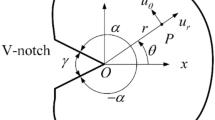Abstract
For the application of the notch stress approach, local stresses at the notch root have to be calculated. This demands a fine discretization of the finite element model in the notch leading for complex structures to large finite element models which are difficult to handle and take a high amount of calculation time. This paper contains the detailed investigation of the required finite element mesh in the notch area for application of the notch stress approach. Based on small-scale specimens, various meshing rules are applied and compared to each other. As the most important factor for the efficiency of a finite element mesh, the element shape in the notch root was identified. It should be chosen according to the stress gradients: The higher the stress gradients are, the smaller the element edge length should be modeled. The shape of the subsequent elements inside the volume has no major influence on the accuracy of the calculation. Recommendations for practical use are given for various element types, including commonly used tetrahedron and hexahedron element with linear and quadratic shape function. Expected numerical errors for the chosen mesh configuration are indicated.














Similar content being viewed by others
References
Bruder T, Störzel K, Baumgartner J, Hanselka H (2012) Evaluation of nominal and local stress based approaches for the fatigue assessment of seam welds. Int J Fatigue 34(1):86–102
Argyris JH, Radaj D (1970) Lösung spezieller parametrischer Kerbspannungsprobleme mit Finite-Element-Verfahren (in German; Solution of special parametric notch stress problems using Finite Element Method), University of Stuttgart, Inst. f. Statik u. Dynamik d. Luft- u. Raumfahrtkonstruktionen, ISD-Report 80
Abaqus User Manual, Version 6.9-1, 2009
Fricke, W (2008) Guideline for the fatigue assessment by notch stress analysis for welded structures, IIW Doc. No. XIII-2240r1-08/XV-1289r1-08, International Institute of Welding
Gorsitzke B, Weiß E, Rudolph J (1999) Regelwerksbasierter Ermüdungsfestigkeitsnachweis geschweißter Druckbehälterkomponenten nach dem Kerbspannungskonzept unter Einsatz der Finite-Elemente Methode (in German; Guideline based fatigue strength verification of welded pressure vessels using the notch stress approach and Finite Element Method). Technische Überwachung 40:31–36
Eibl M, Sonsino CM, Kaufmann H, Zhang G (2003) Fatigue assessment of laser welded thin sheet aluminium. Int J Fatigue 25(8):719–731
Kranz B, Sonsino CM (2010) Verification of FAT values for the application of the notch stress concept with the reference radii r (ref) = 1.00 and 0.05 mm. Weld World 54:R218–R224
Author information
Authors and Affiliations
Corresponding author
Additional information
Doc. IIW-2317, recommended for publication by Commission XIII “Fatigue of Welded Components and Structures.”
Rights and permissions
About this article
Cite this article
Baumgartner, J., Bruder, T. An efficient meshing approach for the calculation of notch stresses. Weld World 57, 137–145 (2013). https://doi.org/10.1007/s40194-012-0005-3
Received:
Accepted:
Published:
Issue Date:
DOI: https://doi.org/10.1007/s40194-012-0005-3




